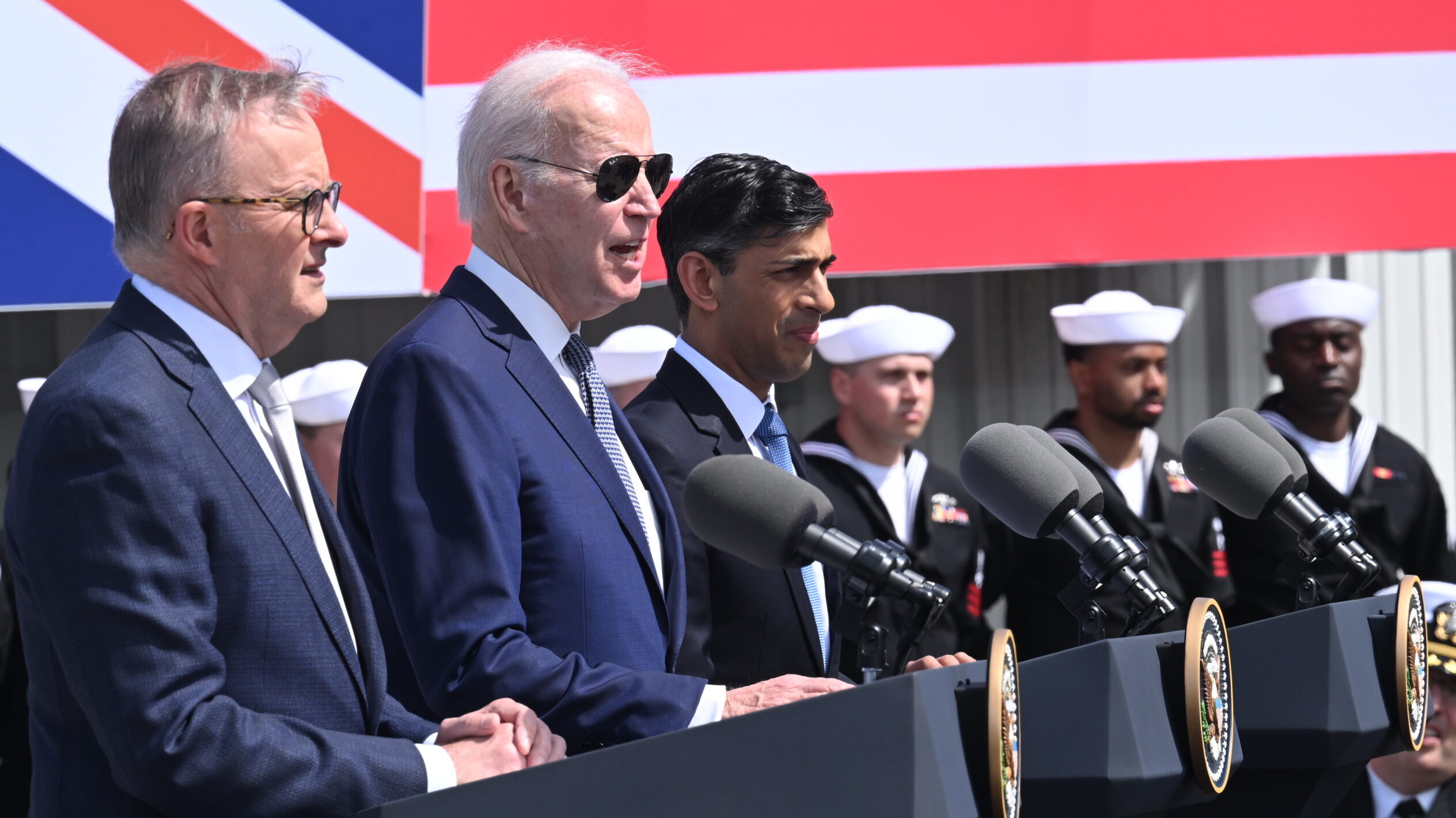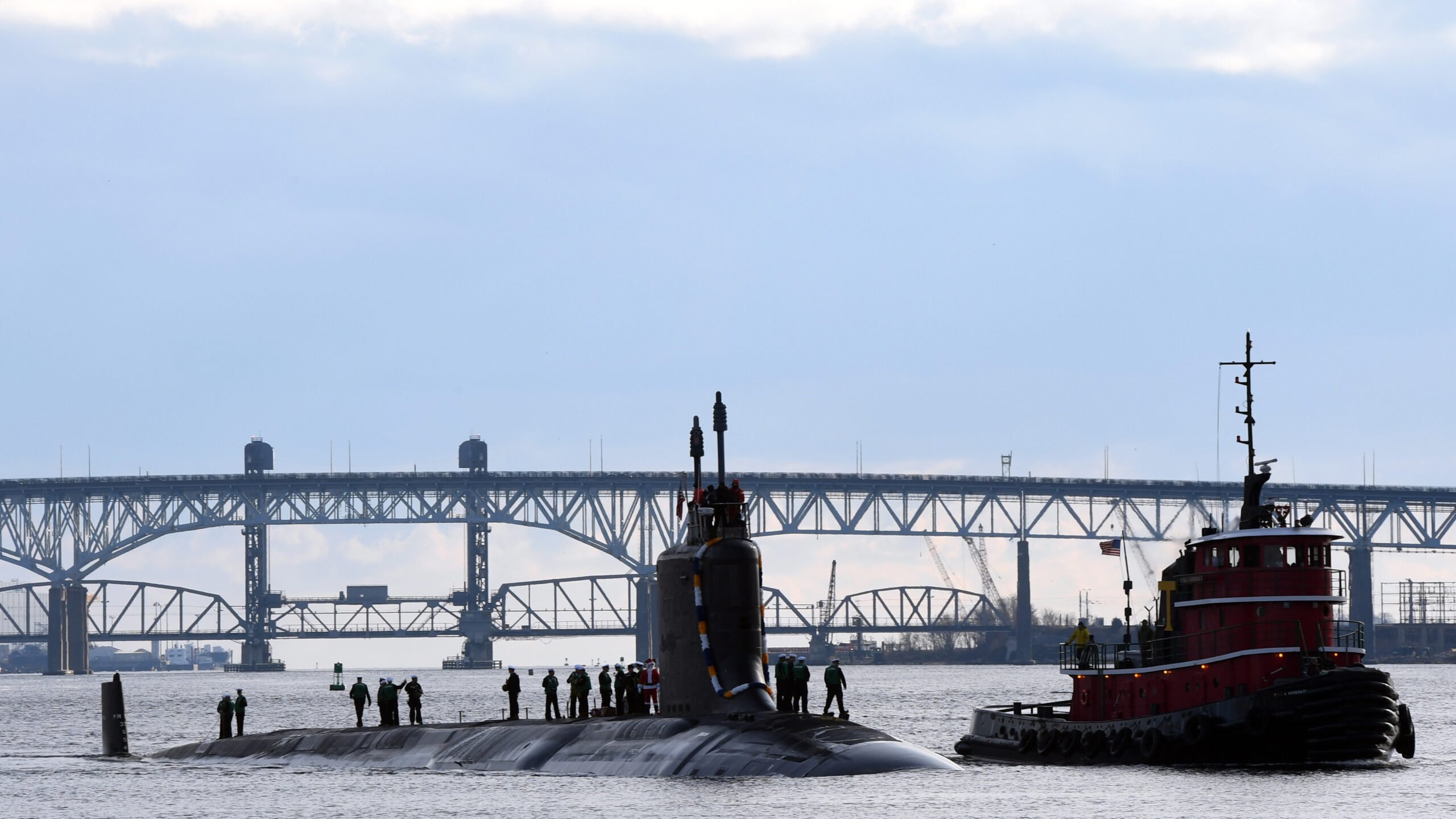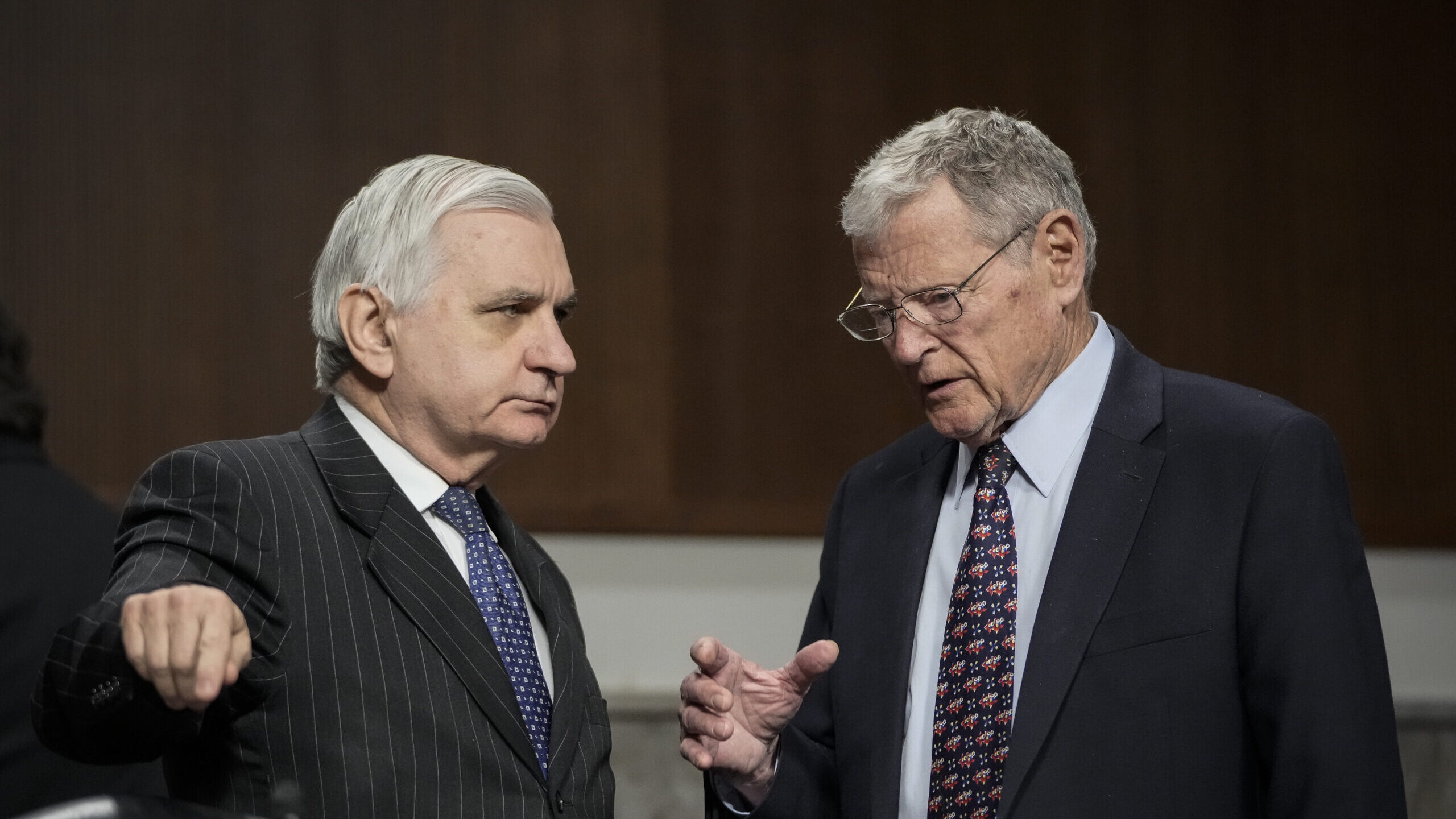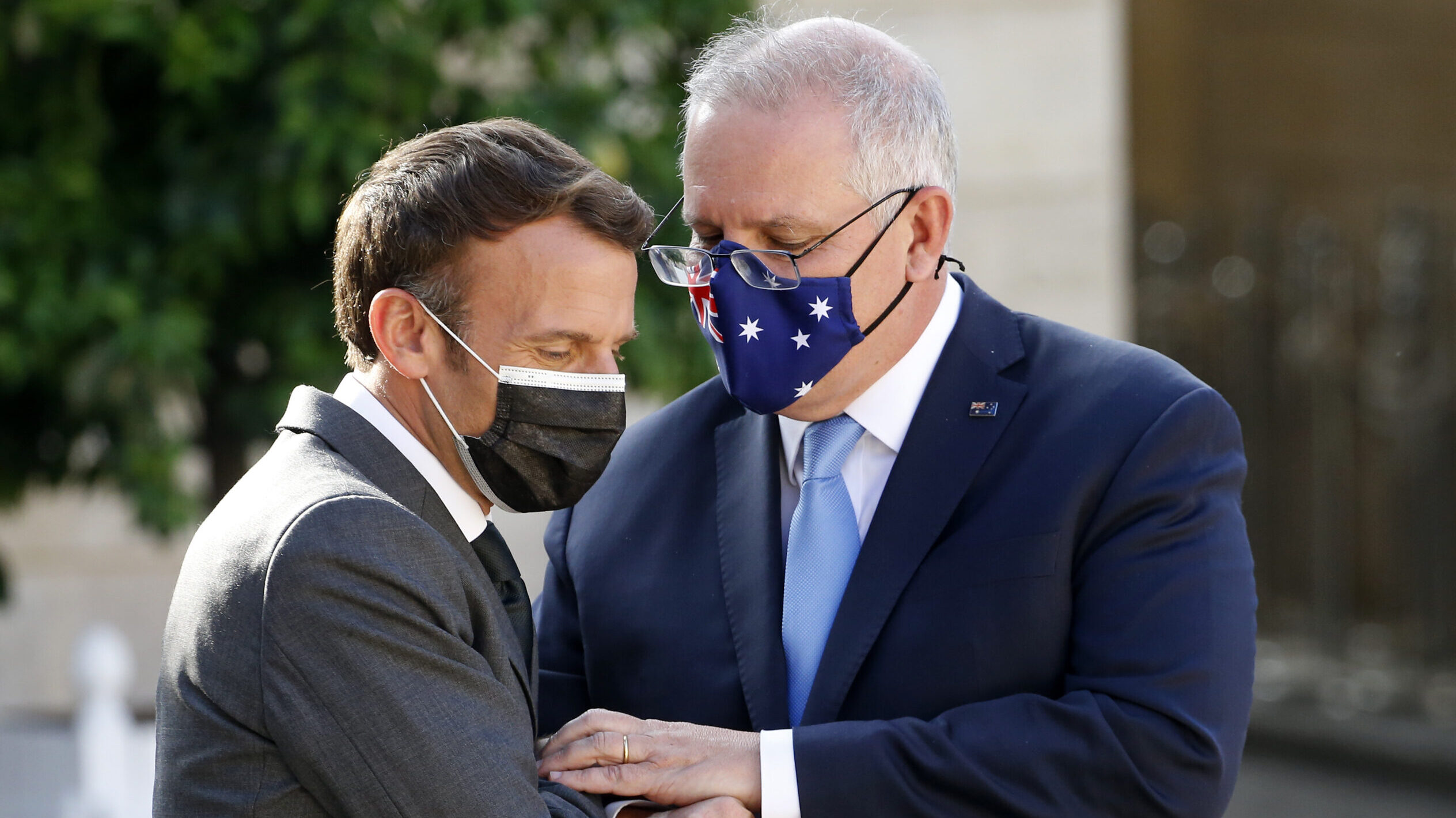
Australian Prime Minister Anthony Albanese (L), US President Joe Biden (C) and British Prime Minister Rishi Sunak (R) hold a press conference after a trilateral meeting during the AUKUS summit on March 13, 2023 in San Diego, California. (Leon Neal/Getty Images)
Updated 2/13/21 at 5:21 pm ET with comments from the AUKUS event.
WASHINGTON — The US, UK and Australia today revealed details of a plan to provide Australia nuclear-powered submarines, with senior administration officials telling Breaking Defense ahead of the event that the outcome will be a “huge” jump in Aussie capabilities and a strategic boon to Washington.
Details include the US selling three Virginia-class subs to Australia in the early 2030s, a new nuclear sub design entering UK service in the late 2030s and Australian service in the early 2040s as well as a brand new basing agreement will give American subs a major strategic hub in the Pacific. But the years-long journey is hardly without its obstacles, and officials acknowledged the White House sees potential for some rough waters ahead.
The plan’s outlines were formally revealed by US President Joe Biden, British Prime Minister Rishi Sunak and Australian Prime Minister Anthony Albanese in San Diego this afternoon, in the next step of the trilateral security pact the countries signed back in September 2021, dubbed AUKUS.
“Our unprecedented trilateral cooperation I believe is a testament to the strength of the longstanding ties that unite us,” Biden said, adding “We’re backing it up with significant investments to strengthen the industrial bases in each of our countries in order to build and support these boats.” The US president also emphasized several times that the sub will be nuclear powered, not armed — a tacit acknowledgement of domestic concerns in Australia over the Lucky Country’s nonproliferation laws.
“For Australia, this whole of nation effort also presents a whole of nation opportunity. We will work with the state governments of South Australia and Western Australia to develop training programs that equip Australians with the skills they need to fill” the jobs created by the AUKUS agreement, Albanese said.
Sunak, for his part, called AUKUS “the most significant multilateral defense partnership in generations,” and tied the agreement to the just-announced plans to increase UK defense spending.
While the leaders’ comments stayed top-level, a more detailed account of the three-phase plan was described to Breaking Defense by senior administration officials ahead of the event.
Since the launch of the agreement, the three nations have been undergoing an 18-month preliminary consultation process. While the AUKUS pact is bigger than just the submarine agreement — the countries have agreed to help one another develop new technologies such as undersea robots, quantum technologies and AI — those capabilities are not the focus of Monday’s announcement, the officials said.
If all goes to plan, not only will Australia bolster its military with technology only held by a handful of countries around the world, but both the United States and the United Kingdom will notch a major strategic advantage in the Indo-Pacific with their own submarine forces gaining a reliable homeport in Australia.
“This is a huge increase in Australia’s capability to operate effectively in the Indo-Pacific,” an official said. “For the US, the strategic benefits of this [are] having more capable partners that are able to bring more assets to a critical region, as well as greater integration with long-standing, incredibly reliable, very capable partners.”
Read more Breaking Defense stories about AUKUS

Virginia-class fast-attack submarine USS South Dakota (SSN-790) transits the Thames River during a homecoming event at Naval Submarine Base New London, Conn. (US Navy)
The Plan: Train, Operate, Build
Phase one, which will take effect immediately, focuses on preparing the Australians, both civilian and uniformed, to take control of a nuclear submarine force.
The country’s shipbuilders will travel to shipyards in both the US and UK to get experience on submarine production lines and its military personnel will embed on American and British submarines, as well as attend military schools focused on training nuclear submarine crews.
Meanwhile, the US and UK will begin what has been dubbed “submarine rotational force west,” which will involve up to four American and one British submarines forward deploying to Perth, located on Australia’s southwestern coast.
The officials said having submarines forward deployed to Australia allows the US to begin taking advantage of the strategic location and gives the Australians experience in starting to manage such vessels. Australia is building up its workforce, both civilian and military, from scratch when it comes to producing and operating nuclear submarines.
To mitigate the time gap between now and when the first next-generation submarine is expected to go on patrol, the plan’s second phase will see the US sell at least three Virginia-class attack submarines, a mix of in-service and new production, to Australia. The officials emphasized the sale will happen “when Australia is ready,” but they anticipated it being done sometime in the early 2030s.
The deal also includes an option for Australia to purchase two additional submarines from the US, but the administration views that option as a safety net in case the next-generation boats become heavily delayed during production.
“We wanted Australia to know that they’d have the option,” the officials said, barring congressional support, “to buy additional submarines should that occur. We don’t expect it.”
US Defense Secretary Lloyd Austin pledged in early December that the US “will not allow” a capability gap to appear between Australia’s Collins-class sub retirement and the deployment of its first nuclear powered attack submarines.
The last phase of the plan involves the production of a new submarine design, dubbed SSN AUKUS. This new boat will effectively act as the United Kingdom’s follow-on program to its Astute-class sub, but will take advantage of “extensive amounts” of American technologies from the Virginia-class. If everything goes to plan, the UK will produce its first SSN AUKUS in the late 2030s and the Aussies will follow suit in the early 2040s, the officials said.
By using a British boat design, American technologies and Australia’s workforce, all three countries will achieve “significant integration of [their] supply chains,” the officials said.
On paper at least, the agreement should be a boon for the US submarine industry. The supplier base is slated to receive increased domestic funding from the White House as well as foreign investment from the Australians as a result of the deal.
But that doesn’t mean the agreement is without hurdles.

Sen. Jack Reed (left) talks with then-ranking member Sen. James Inhofe (right) before the start of a Senate Armed Services hearing in March 2022. (Photo by Drew Angerer/Getty Images)
Deep Sea Mines In The Details
Between congressional approvals, laws regulating technology transfers and an industrial base already reaching its limit, there’s no shortage of potential obstacles capable of torpedoing the plans to deliver SSN AUKUS.
As Breaking Defense first reported, Senate Armed Services Committee chairman Sen. Jack Reed, D-R.I., and now-retired Sen. James Inhofe, R-Okla., in a letter to the White House last year, raised concerns that the extra pressure on the US industrial base to assist Australia may eventually harm the US Navy’s own submarine fleet. Other members have raised worries as well.
Related: EXCLUSIVE: Reed, Inhofe warn Biden AUKUS risks becoming ‘zero sum game’ for US Navy
Asked about lawmaker concerns, the officials said Australia has committed to investing into the US industrial base and the Australians are having similar discussions with the Brits about investing in the United Kingdom’s industrial base. They also cited efforts by the Pentagon to bolster the industrial base through domestic spending.
“The US and this administration are going to recommend really turning up the dial on investment in [the] submarine industrial base. The Aussies will contribute, but theirs will be a proportional share, and it will be in relative terms a small share because they will [only] be purchasing three, or at most five, of our submarines,” an official said. (The officials did not share more details on how much money Australia would be investing or where it would go.)
The US industrial base consists of only two prime contractors able to build and maintain nuclear-powered submarines, HII and General Dynamics Electric Boat. The officials said direct discussions with those companies and other suppliers has been “limited” due to the sensitivity of the trilateral negotiations, but they added that they expect more in-depth discussions following the White House’s announcement today.
Another challenge involves the US laws that surround advanced technology transfers with foreign countries. As an example, despite being members of the Five Eyes intelligence-sharing network and the longstanding military relationships between the three, the US, UK and Australia had to set up a special agreement back in September 2021 just to conduct the 18-month consultation period in which only information was shared.
As a result, at least one American lawmaker is already pushing for Congress to create a “circuit breaker” for the International Traffic in Arms Regulations (ITAR) export control regime, in order to allow the AUKUS agreement to move forward. However, given how slowly Congress can move, and the complexity of export restriction laws, it’s unclear exactly what shape that could take or when it could be implemented.
The officials said AUKUS will require a mutual defense agreement with Australia, similar to what the United States and United Kingdom established in the 1950s — which requires congressional approval. As for the technology transfers, the officials acknowledged that current US laws require streamlining and that the Defense and State Departments have begun a “systematic review” to understand the extent of the issues requiring changes. Following those reviews, the administration will start working with Congress to make legislative changes as necessary.

French President Emmanuel Macron (L) welcomes former Australian Prime Minister Scott Morrison (R) prior to a working dinner at the Elysee Presidential Palace. (Photo by Chesnot/Getty Images)
What To Tell Paris?
The announcement of the AUKUS security pact in 2021 was preceded by Australia terminating a previously negotiated deal with Paris for French-built submarines. Naturally, diplomatic tensions were high among the four parties following the announcement, with France temporarily recalling its ambassadors to Washington and Canberra in protest.
Since, the administration officials said they have consistently reached out to the French as the AUKUS negotiations have proceeded, and while there’s no expectation for Paris to ever “love” the agreement, the White House believes there is a mutual understanding.
“The French reaction last time around is something that we don’t want to see repeated,” an official said. “We understand that they probably will not grow to love AUKUS and we’re not expecting [them to]… but at the same time, we believe that they understand the rationale, that they understand what is being done [and] that they will not be surprised.”
Colin Clark contributed to this report from Sydney.








